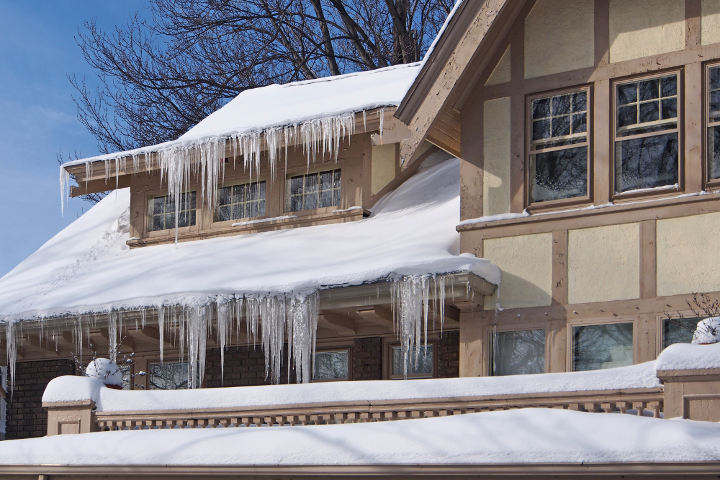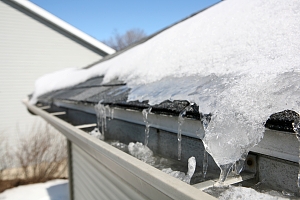Snowfall brings about a picturesque winter wonderland, but it can also pose serious threats to the structural integrity of roofs. The accumulation of snow on rooftops can lead to various winter roof damage issues, such as frozen blocked pipes and ice damming. Understanding these potential problems is crucial in order to protect your home during the winter months.
In this article, we will explore how snow affects roofing and discuss some solutions to mitigate winter roof damage.
How Snow Affects Roofing
Understanding how snow affects roofing is essential for homeowners and building managers to protect their properties.
Roof Load and Structural Integrity

Snow can have a significant impact on the roof load and structural integrity of buildings, especially in regions prone to heavy snowfall. As snow accumulates on a roof, it adds weight, exerting pressure on the structure. This additional load can exceed the design limits of the roof and compromise its stability. The weight of snow can also cause stress on the supporting beams and columns, potentially leading to structural damage or even collapse.
Furthermore, as snow melts and refreezes, it can create ice dams, which impede proper drainage and further increase the load on the roof. Therefore, it is crucial for building owners and managers to regularly monitor snow accumulation, implement proper snow removal techniques, and ensure that roofs are designed to withstand anticipated snow loads to maintain the structural integrity of the building and prevent potential hazards.
Freeze-Thaw Cycles
Temperature fluctuations during the winter can subject roofs to freeze-thaw cycles. As snow melts during the day, it can penetrate small cracks and crevices in the roof. When the temperature drops at night, the water refreezes, expanding and potentially widening these gaps.
Over time, this freeze-thaw cycle weakens the roof’s protective layers and can lead to leaks and structural damage. Regular inspections and timely repairs can help mitigate the effects of freeze-thaw cycles.
Roofing Material Damage
Certain roofing materials are more susceptible to snow-related damage. For instance, asphalt shingles can become brittle in cold temperatures, making them prone to cracking or breaking when snow is present.
Flat or low-slope roofs with inadequate drainage systems may experience ponding water, which increases the risk of water infiltration. Metal roofs, on the other hand, tend to shed snow more easily due to their smooth surface and steeper slopes.
Frozen Blocked Pipes
When snow accumulates on your roof, it can block the vents and pipes that are designed to allow proper airflow and drainage. This blockage prevents the natural escape of moisture from your home, leading to potential damage. The trapped moisture can result in pipe bursts, water leaks, and even structural issues. Regularly inspecting and clearing blocked pipes during the winter can help prevent such problems.
Ice Damming
Ice damming occurs when snow on the roof melts due to heat escaping from the attic, only to refreeze when it reaches the colder edges of the roof. This refrozen water creates ice dams, which prevent proper drainage and cause water to back up under the shingles. This can lead to leaks, water damage, and even mold growth inside the home.
Causes of Ice Damming
Several factors contribute to the formation of ice dams. Poor insulation and inadequate ventilation in the attic allow warm air to escape, melting the snow on the roof. Additionally, a lack of proper sealing around vents, chimneys, and other roof protrusions can allow warm air to escape, contributing to the melting and refreezing cycle. Addressing these issues can help prevent ice dams from forming.
Winter Roof Solutions
 To protect your roof from winter damage, there are several solutions you can consider:
To protect your roof from winter damage, there are several solutions you can consider:
Insulate and ventilate the attic
Adequate insulation and proper ventilation in the attic can help maintain a consistent temperature on the roof, preventing snow from melting and refreezing.
Clear snow regularly
Removing snow from your roof with a roof rake or hiring a professional snow removal service can help prevent excessive accumulation and minimize the risk of ice dams.
Install heat cables
Heat cables can be installed along the roof edges and gutters to prevent ice dams by melting the snow and allowing it to drain properly.
Consider a Metal Roof
Metal roofs are highly resistant to snow accumulation and ice dam formation. The smooth surface of metal prevents snow from gripping onto the roof, allowing it to slide off more easily. Additionally, metal roofs shed snow more effectively due to their steeper slopes. Consider consulting with a roofing professional to determine if a metal roof is a suitable option for your home.
Contact the Northern Virginia Winter Roofing Damage Repair Experts
Winter weather can have a significant impact on your home’s roof, particularly when it comes to snow. By understanding how snow affects your roof and taking steps to prevent damage caused by blocked pipes and ice damming, you can protect your home and avoid costly repairs. Consider consulting with Dirt Connections, the professional roofers in Northern Virginia, Delaware and Maryland to determine the best course of action for your specific situation.









































